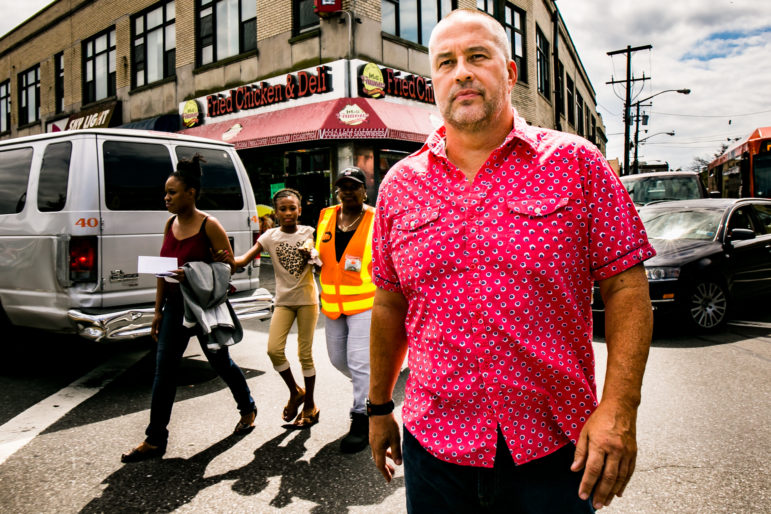
Adi Talwar
Queens CB 14 District Manager Jonathan Gaska: 'They are leaving the boards out of the loop on certain things that they never used to before.'
At the end of a September 12 board meeting, Chairman Vincent Arcuri Jr. of Queens Community Board 5 thanked his hosts, the Christ the King Church in Middle Village, and made reference to a new speaker system that the board acquired, gesturing to a tangle of wires connected to a mixer which sat on cafeteria desks. At a meeting where board members argued vigorously over issues like a new homeless shelter in Maspeth, the seemingly minor acquisition generated applause, a boon to a community board that gets little funding for new communications.
Older Board members and district managers complain that the board’s funding stagnated and its influence waned during the previous two mayoral administrations, the latter point highlighted when the de Blasio administration passed citywide zoning legislation despite overwhelming dissent from the city’s boards last year. This included “no” votes 12 of the 14 Queens Community Boards.
Despite the fact that their funding has increased in the previous two budget cycles—spending on all 59 community boards now surpasses $15 million a year—long-time district managers say boards are still funded at the bare minimum and that their advisory votes are taken less seriously than in the past.
District Manager Jonathan Gaska is among those who believes that the influence of community boards has been in decline since the early 2000s.
“They are leaving the boards out of the loop on certain things that they never used to before,” Gaska says. There is a common sentiment, as Gaska tells it, that city agencies in the de Blasio era do the minimum amount of outreach mandated by the city charter when presenting a new project, and are disinterested in feedback if it contradicts the city’s vision.
“There’s years where it’s difficult,” says Gary Giordano, the district manager of Queens Community 5, which encompasses Ridgewood, Maspeth, Middle Village, and Glendale. He notes that at 170,000 people, Community Board 5’s size is modest compared to other Queens districts—but each has the same budget to spend, regardless of size.
In the last fiscal year each board had a $233,000 budget, most of which goes to salaries of its two full-time employees, the chairperson and district manager. Giordano made $75,000 in 2015.*
Many boards employ one to three part time assistants at salaries that range between $30,000 and $45,000. The city also provides rent money for board meetings, an amount not factored into the annual budget. Queens Community Board 5 meets at Christ the King Church, which provides space for under $100 per meeting as a community service, according to Giordano.
‘Mayor Rudy Giuliani cut the boards’ budget by a million dollars in 1994, his first year in office. According to Independent Budget Office data, the budget slowly increased in the subsequent two decades, and jumped by 800,000 dollars between 2014 and 2015, the first year that Mayor de Blasio was in office. It now exceeds the pre-Giuliani budget even when inflation is accounted for.
Still, Yvonne Reddick, district manager of Queens Community Board 12, whose district encompasses Jamaica and has a population of a quarter million people, says that it can be challenging to manage with the budget they’re allotted.
“We’re the second largest board in Queens county and it’s growing,” Reddick says. “We could use more money in our budget.” When Reddick spoke to City Limits she says she was the only person in the community board office available to answer the phone, a role that many district managers take on while also conducting meetings and dealing with budgetary issues.
Gaska says that budgetary limits inhibit outreach and communication. He notes that his community board’s phone system is 22 years old, and he’s been trying to get the city to replace it for years. But a new phone system would cost between $5,000 and $10,000, he says, which the board would have to pay for itself. All additional technology comes out of the budget, including laptops, computers and new equipment.
But the city has been working with boards to update their web presence. DOITT, the city’s Department of Information Technology and Telecommunications, recently updated a handful of boards’ websites, including Queens Community Board 5 and 12. Gaska was eager to get his board’s site updated and says the agency was easy to work with. Reddick, too, praised DOITT on their work updating her boards’ website.
Most community boards have websites, though some are not updated frequently, or are listed as being “under construction.” Brooklyn Community Board 18 lacks a website altogether, as does Staten Island Community Board 2. And few of the boards post minutes from monthly meetings.
Boards also make use of local press and media. At a recent Community Board 5 meeting, Chairman Arcuri Jr. on several occasions gestured to a table of press members huddled in the back, all reporters in their twenties who work for the three community newspapers in the community district that Queens CB 5 encompasses. The Queens Community Boards also advertise meeting times on Queens Public Television, which is available to FIOS and cable subscribers.
Gaska, who has served on the community board since the Koch administration, is resolute that whatever the future of the boards, he’ll still approach the work the same way.
“We deal with what we have, and we have done that for the last 20 years,” he says.
Correction: The original version of this story erroneously reported that board chairpersons are paid. They are not.
Read the rest of the series here.
* * *
City Limits’ coverage of housing policy is supported by the New York Community Trust and the Revson Foundation









One thought on “City’s Community Boards Play Bigger Role Within Tight Budgets”
Good article.
However, one correction is necessary: community board chairpersons, like all other board members, are volunteers and are not paid.
Angel Mescain
District Manager
Manhattan CB11